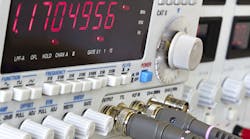Modern Communications Drives Demand for Signal Generators
The evolution of wireless standards, such as LTE-Advanced and IEEE802.11ah, has increased demand for signal generators that can accurately test telecommunications equipment and electrical components, according to a recent report from the research firm Markets and Markets. These new standards in wireless communications are causing significant growth in the signal-generator market, the report says.
The market for signal generators is expected to earn revenues of approximately $1.22 billion in 2020, up from the $755 million earned last year, the report says. The report analyzes the entire market, from general-purpose and function generators to microwave and RF instruments. The main reason for the market's growth, the report says, is the growing need to test complex communication systems. Specifically, the report underlined the complex modulation techniques and communications standards that are emerging around 5G wireless networks.
The telecommunications industry, the report states, will remain the largest customer for signal generators over the next five years, followed closely by electronics manufacturing. In North America, which will hold the largest share of the global market, signal generators remain a necessary tool in aerospace, defense, and telecommunications testing. In Asia, on the other hand, the growth of electronics manufacturing is expected to bolster demand for these instruments.
For communications, there are two main types of signal generators. In general, RF signal generators operate below 6 GHz and are geared toward testing telecommunications equipment. While older RF signal generators are still necessary to test equipment using 2G and 3G signals, many wireless operators are starting to phase out or recycle the bands reserved for these networks. The other kind, microwave signal generators, operate in higher frequencies and are mostly used for testing radar systems, satellite and aerospace equipment, and electronic warfare (EW) components.
The report notes that one of the main restraints on the market comes from the intense competition among companies to keep prices down. Several RF signal generators, such as the DSG800 Series from RIGOL Technologies and the Windfreak SynthNV, have starting prices under $2,000. On the other hand, certain RF vector signal generators, which can accurately replicate signals recorded by an analyzer in the field, can command prices over ten times that amount. Keysight's N5172B EXG RF vector signal generator, for instance, costs $22,295.
In an article with Microwaves & RF, Riadh Said, platform manager for Keysight's Microwaves and Communications division, notes that the cost of signal generators also varies with phase noise, bandwidth, output power, and modularity. In response, manufacturers are releasing software upgrades that not only target wireless standards but also control the power, frequency, and modulation of the instrument. The report notes that manufacturers have also started to design custom equipment for specific industries.
The report notes that signal generators have the most potential for growth in the development of human-machine interfaces (HMIs). This is especially true as technology within the Internet of Things (IoT) becomes more automated with software and embedded processors.
